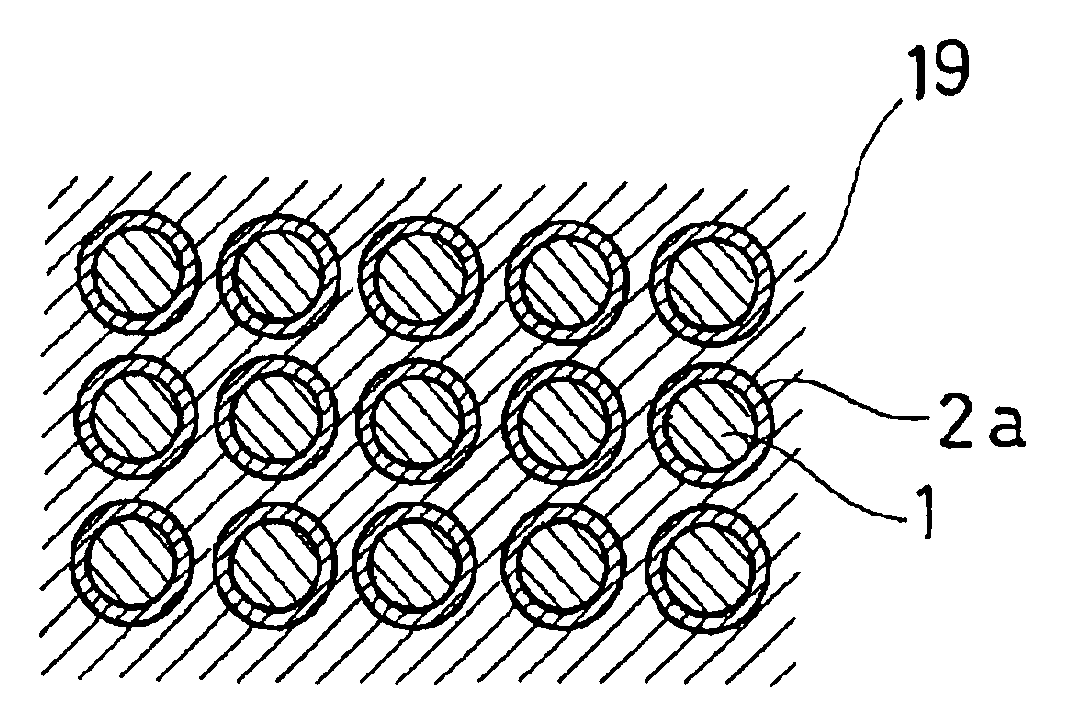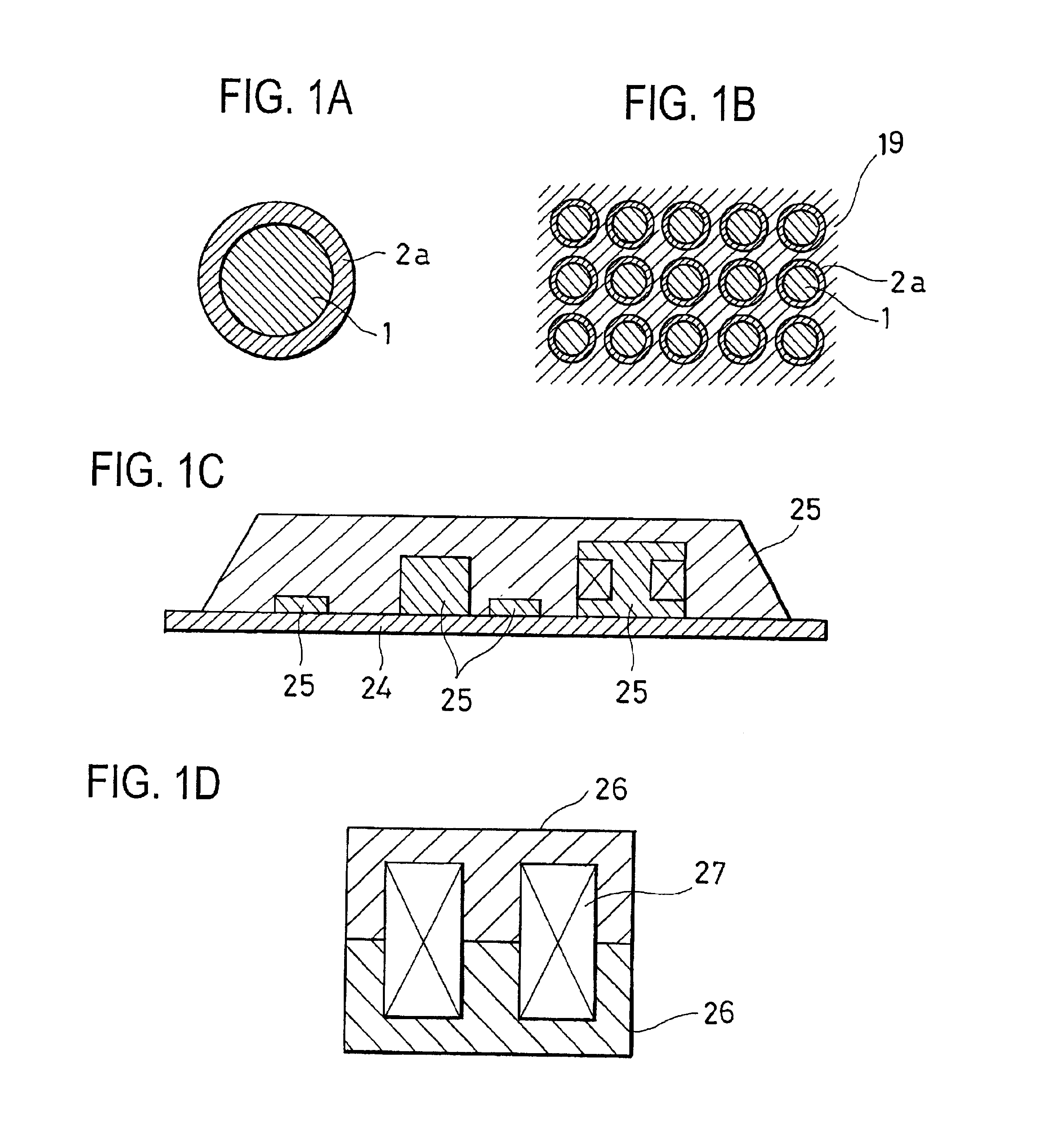Composite magnetic material and magnetic molding material, magnetic powder compression molding material, and magnetic paint using the composite magnetic material, composite dielectric material and molding material, powder compression molding material, paint, prepreg, and substrate using the composite dielectric material, and electronic part
- Summary
- Abstract
- Description
- Claims
- Application Information
AI Technical Summary
Benefits of technology
Problems solved by technology
Method used
Image
Examples
example 1-2
Magnetic Molding Material (Shield Member)
[0234]For use in an exemplary shield member as shown in FIG. 3B, metal particles were prepared by the spray pyrolysis process so that a BaTiO3 layer might deposit on the surface of nickel cores. The BaTiO3 layer was deposited such that BaTiO3 was 1 wt % or 10 wt % based on nickel. On x-ray diffraction analysis, the coated metal particles were found to consist of nickel and BaTiO3. The particles had a particle size distribution of 0.1 to 1.3 μm and a mean particle size of 0.6 μm.
[0235]In a ball mill, the thus prepared metal particles were mixed and dispersed in a liquid epoxy resin in such amounts as to give a metal particle content of 40 vol %. The dispersion was formed into a sheet of 200 μm thick by a doctor blade technique, and dried into a magnetic shield sample. From an observation under FE-SEM and measurements of insulation resistance and withstanding voltage (Table 1—1), it was found that BaTiO3 existed on the surface of nickel particl...
example 1-3
Magnetic Paint
[0236]The composite magnetic material of the invention enables supply of a variety of magnetic paints such as printing paint adapted for screen printing. A magnetic paint was prepared by dissolving titanyl, barium and iron salts in water in such amounts that barium titanate was 10 wt % based on iron and heat spraying the resulting aqueous solution into barium titanate-coated iron particles having a mean particle size of 0.6 μm as in Example 1-1. The iron powder was mixed with an ethyl cellulose resin along with a mixture of butyl carbitol and terpineol. Specifically, the ingredients were mixed and dispersed in a ball mill using steel balls. The composition was such that the coated metal particles were 40 vol % in the ethyl cellulose resin.
[0237]By a screen printing technique, the paint was repeatedly applied to a thickness of 0.1 mm. The magnetic permeability (μ′ and μ″) versus frequency of the laminate was examined, obtaining substantially the same response as the mag...
example 1-4
Magnetic Powder Compression Molding Material
[0239]When a heat compression molding technique is employed, the composition magnetic material of the invention enables to increase the amount of coated metal particles added to a resinous material and to provide a magnetic molded article having a high magnetic permeability and improved insulation.
[0240]Barium titanate-coated iron particles having a mean particle size of 0.6 μm were prepared by dissolving titanyl, barium and iron salts in water in such amounts that barium titanate was 10 wt % based on iron and heat spraying the resulting aqueous solution as in Example 1—1. The powder, 3 wt %, was mixed with an epoxy resin. Using a mold having an outer diameter of 7 mm and an inner diameter of 3 mm, the mixture was press molded at 180° C. and 500 kPa into a toroidal magnetic compact, which was examined for magnetic characteristics. Because of high loading, there was obtained a composite magnetic material having a high magnetic permeability ...
PUM
| Property | Measurement | Unit |
|---|---|---|
| Percent by mass | aaaaa | aaaaa |
| Thickness | aaaaa | aaaaa |
| Thickness | aaaaa | aaaaa |
Abstract
Description
Claims
Application Information
 Login to View More
Login to View More - R&D
- Intellectual Property
- Life Sciences
- Materials
- Tech Scout
- Unparalleled Data Quality
- Higher Quality Content
- 60% Fewer Hallucinations
Browse by: Latest US Patents, China's latest patents, Technical Efficacy Thesaurus, Application Domain, Technology Topic, Popular Technical Reports.
© 2025 PatSnap. All rights reserved.Legal|Privacy policy|Modern Slavery Act Transparency Statement|Sitemap|About US| Contact US: help@patsnap.com



